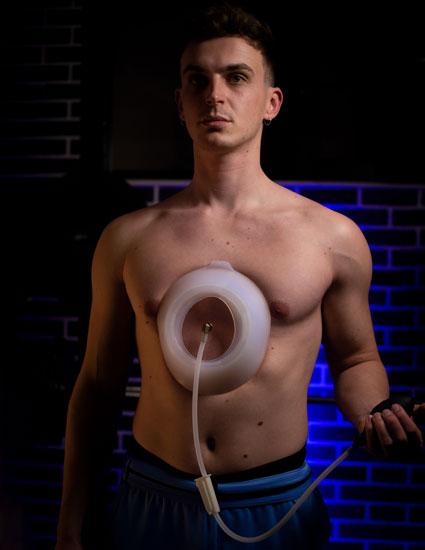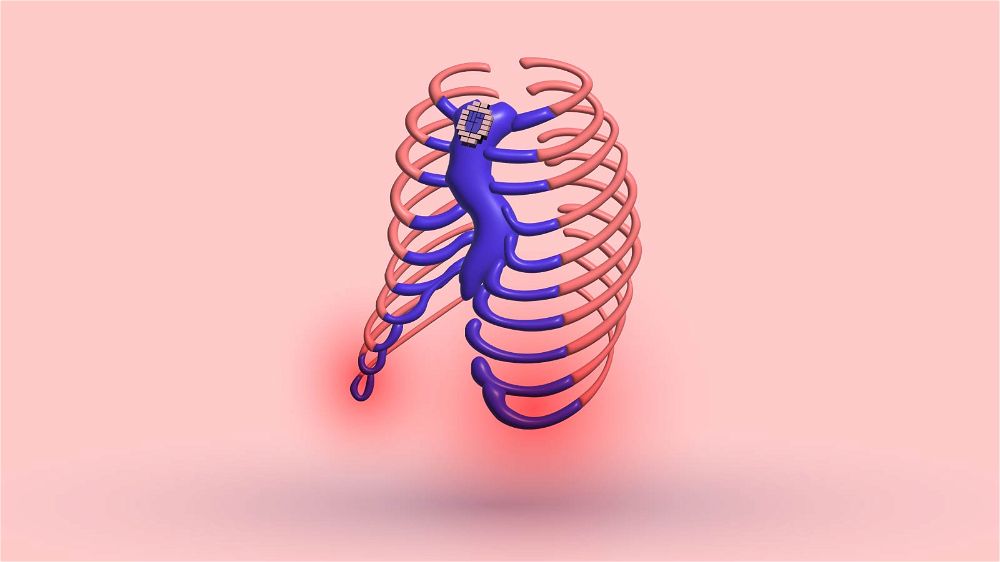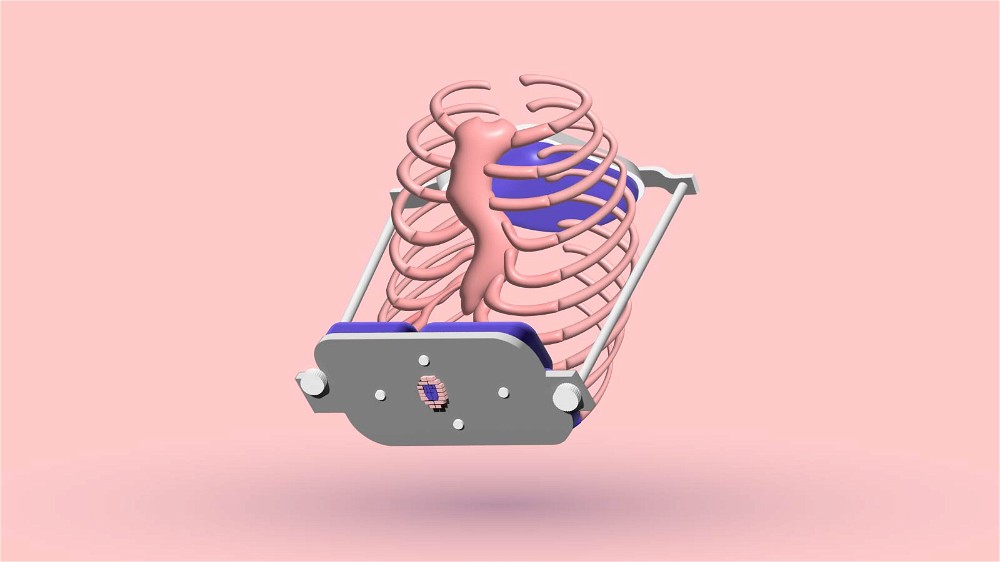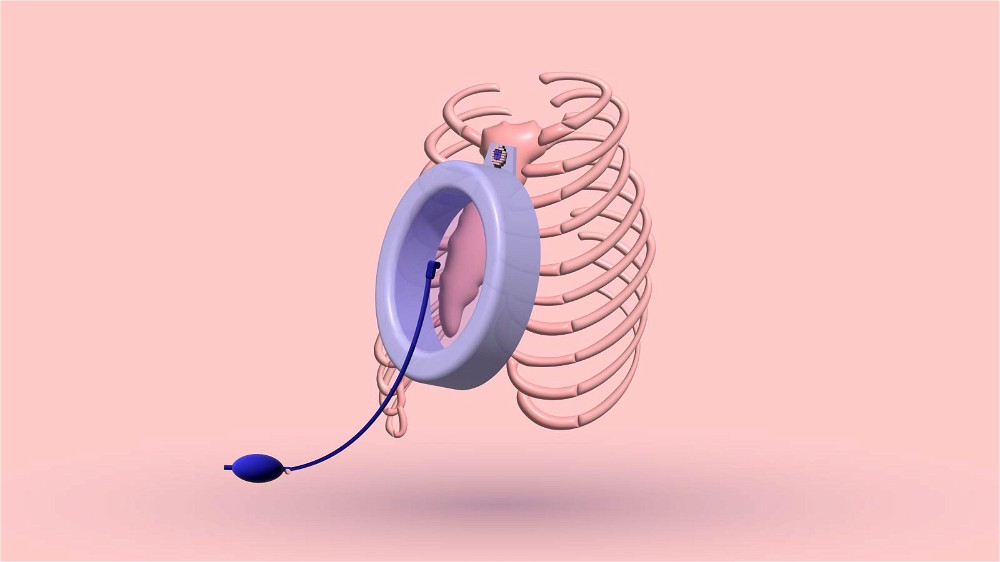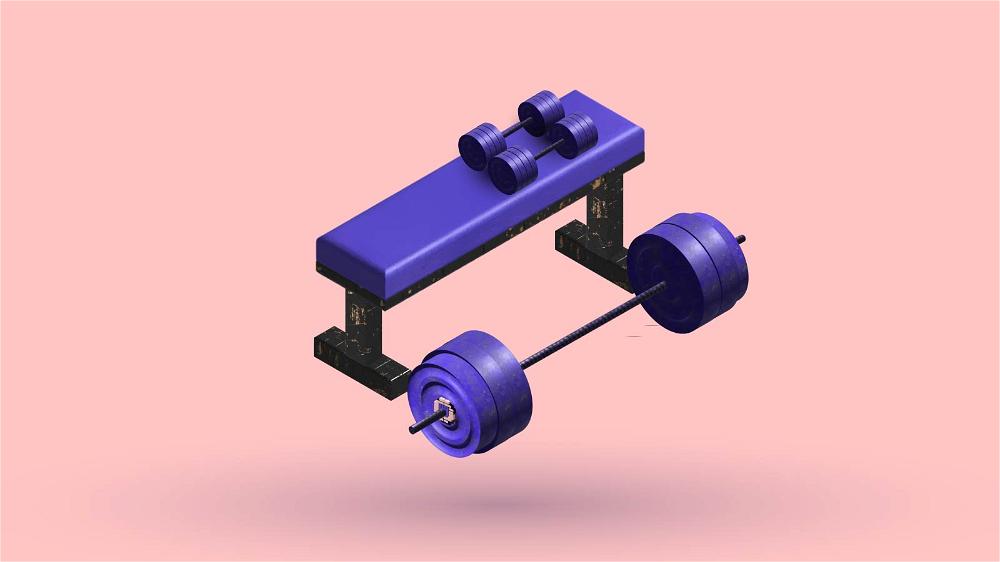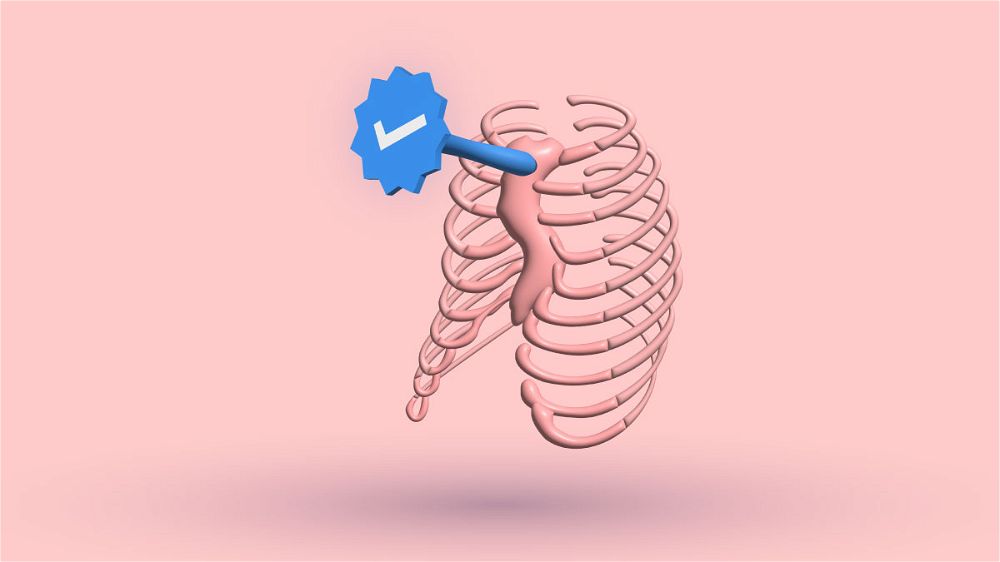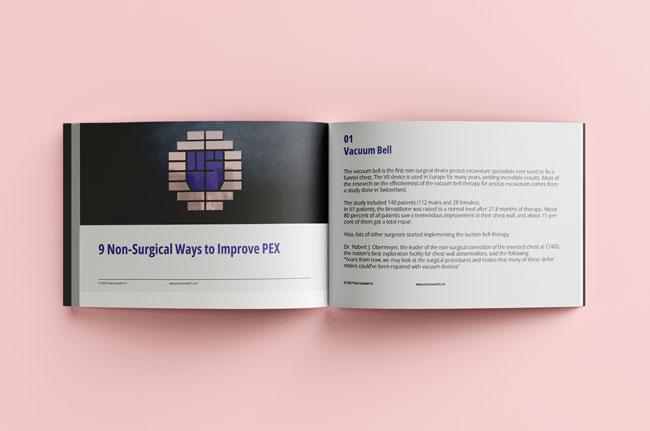Breathing exercises can improve restricted breathing patterns and help you improve life with pectus excavatum. I will recommend a few exercises that helped me make my life easier while reducing pectus excavatum-related shortness of breath.
PECTUS EXCAVATUM HINDERED MY BREATHING

Pectus excavatum can restrict the ability to breathe deeply. I experienced this personally and felt the tension in my chest and my back. It made me feel neurotic.
My energy was displaced away from my pelvic floor, the center of our energetic existence. You will start losing your grounding when the muscular system tenses around your funnel chest and stomach.
You will start to speak before you think, have a shaky and soft voice, and look unconfident. That's why some individuals with pectus excavatum have trouble seducing members of the opposite sex.
SHALLOW BREATHING IS HARMFUL
One of the most harmful types of neurotic holding patterns is restricting the respiratory pathways. Shallow breathing caused by pectus excavatum creates mental and physical fatigue.
It reduces the oxygenation to your body and brain. That's a big enough reason why you must practice breathing exercises. The exercises I will show you below will make your respiratory muscles strong.
DIAPHRAGM IMPORTANCE
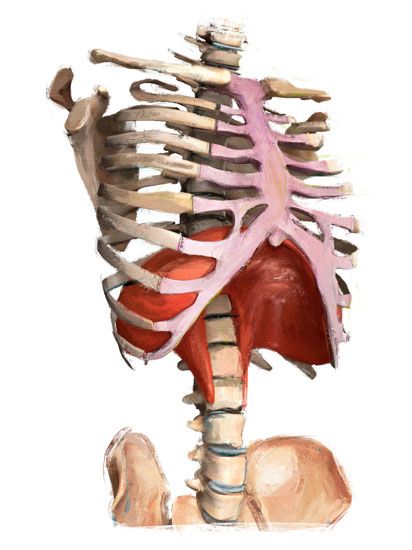
The diaphragm is the most important muscle when it comes to breathing. It brings about 80% of the muscular breathing power. It is formed like an umbrella and is located just underneath your lungs.
When this muscle contracts, it straightens, expands the lungs, and creates room for a bigger breath. A strong diaphragm will let go of air trapped in the lungs and increase oxygenation levels.
WHAT IS DEEP BREATHING

When I say deep breathing, you must reduce the erratic holding patterns (muscular rigidity) in your:
- Jaw
- Neck
- Shoulders
- Chest
- Abdomen
- Pelvic floor
All these are called accessory muscles of respiration. When you do proper deep breathing, that means your entire body is relaxed. All neurotic holding patterns linked with these muscles cause breathing problems.
In our case, you must focus on getting rid of the tightness in the chest. The pectus excavatum deformity is causing rigidity in this area. You can bring the respiratory wave down on your pelvic floor when these muscles are relaxed.
This will make you more "grounded." You'll be more in control of your actions, thoughts, and feelings. This will help you tremendously deal with the deformity on a psychological level.
BREATHING WILL HELP YOU DEAL WITH ANXIETY
Some people with pectus excavatum deformity suffer from depression and social anxiety. I was one of these people. I had trouble talking with members of the opposite sex because I was nervous. I was shy and out of control while socializing.
Deep breathing helped me tremendously in dealing with this. You can achieve deep breathing by stretching the accessory muscles of respiration I previously mentioned.
CONTROLLED DEEP BREATHING IS A MUST
Before you start breathing exercises, you must know how you breathe. Focusing on deep, diaphragmic breathing while doing all exercises and stretches would be best. Pay attention to the inhalation and exhalation.
TOP 6 BREATHING EXERCISES
SITTING BREATHING EXERCISE
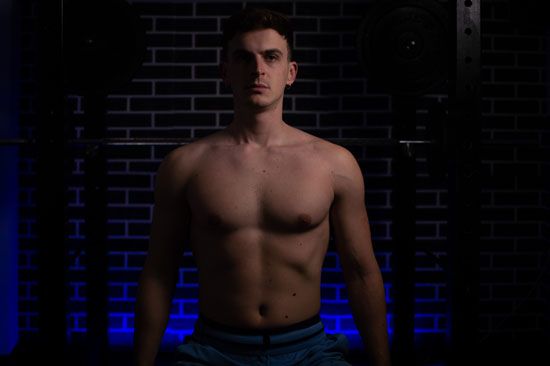
When you wake up, sit on a chair with your back straight and your arms by your side. Squeeze your shoulder blades together. Slowly inhale deeply, and keep the air inside your lungs for about ten seconds.
Focus on elevating the anterior chest wall cavity. Then, slowly exhale and repeat. Try to do ten repetitions of this in the morning and 10 in the evening.
This breathing exercise will also give you a lot of energy to start the day. It is normal to feel dizzy because your body isn't used to holding this amount of oxygen. Sufferers with pectus posture feel dizziness more often than others.
That's because their frontal body musculature is tight, which hinders the body's breathing mechanism. If you feel like fainting, stop immediately.
THE BOW

The bow is the best stretching/breathing exercise to open your respiratory pathways. I learned this exercise from Elliott Hulse. I became a massive fan of his after doing this excellent breathing exercise.
Stand with your feet set shoulder-width apart. Press with your fists high on your lower back. Then, lean back with your body and open your mouth and eyes as wide as possible.
Start breathing deeply, and try to raise your stomach with your breath. You can even put your hands above your head to feel a more significant stretch in your extra respiratory muscles.
You'll start to shake and vibrate. You'll feel tightness in your chest because your deformity and vibration help break the neurotic holding patterns in your muscles.
At first, this breathing exercise will feel very weird and challenging. Start slowly and try to progress gradually. Aim to perform ten breaths for three sets, with 60 seconds of rest between sets.
BALLOON THERAPY

Balloon therapy is an excellent way to strengthen your diaphragm and core musculature. The balloon is a resistance to your exhalation and forces you to blow out hard. Just like doing a bench press for your chest muscles, you should also do this exercise to strengthen your respiratory muscles.
After a few weeks, you'll notice that you're less tired because of the increased circulation to your brain and heart. To do this exercise, you'll need a simple balloon.
- First, stretch out the balloon, so it becomes more flexible. This will lower the chances it will blow up in your face. I learned this the hard way.
- Take a breath and exhale in the balloon until your lungs are empty.
- Squeeze the balloon with your fingers so the air won't come out.
- Then, breathe normally and take a second deep breath. Try blowing more air in the balloon this time than you did the first time.
- Lastly, take a final, third deep breath and blow into the balloon.
Perform three sets of 3 breaths for this exercise and do it three times a day. I recommend putting the balloon next to your toothbrush to make this exercise a habit. Doing this breathing exercise will be accessible when you wake up and sleep. My doctor advised me to do this balloon breathing exercise right after I was diagnosed with pectus excavatum.
He even showed me scientific evidence that this exercise improves pulmonary functions in people. At first, I thought this was a silly exercise. However, after a few weeks, I realized I had slightly elevated my cavity. I could finally feel my stomach expanding when I took a full breath.
BIOENERGETIC STOOL BREATHING

I recommend you perform this breathing exercise before or after doing the pectus excavatum exercises focused on the upper body. To do the exercise, you'll need to build a bioenergetic stool. Don't worry; this is easy to make and costs no more than $20.
It would be best if you had a bar stool, a Dowel rod I purchased from Amazon, a towel, and bungee cords to hold onto the seat. This stool allows you to perform three breathing exercises to stretch the tight muscles around your sunken breastbone.
HANDS OVERHEAD
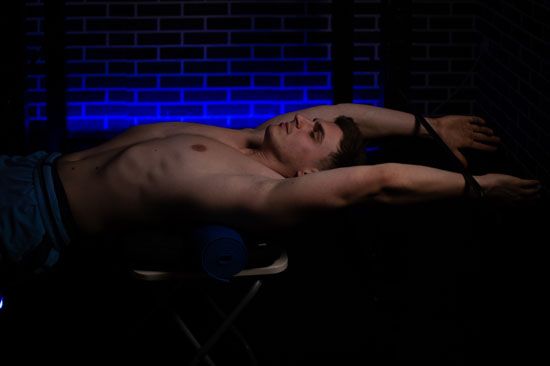
For the first breathing exercise, you'll need to lay your shoulders on the towel. Set your feet at shoulder-width apart and point forward. Extend your arms above your head and open your eyes and mouth as wide as possible. Then, breathe deeply and lift your sunken breastbone with your breath.
You'll feel extremely uncomfortable in this position, which is perfectly normal. You'll shake and vibrate all over the stool. That's precisely what you need. You should feel that if you want to release the muscular tension in your upper body. Aim to perform 10-15 breaths in this position. Then, rest for 60 seconds and switch positions.
MIDDLE BACK ON STOOL
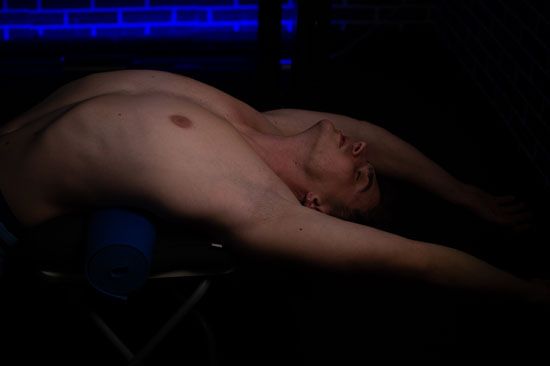
Next, you'll lay with your middle back on the towel. Fully extend your arms, just like in the previous breathing exercise. However, the only difference is that you'll need a bed or a couch to rest your arms.
That balances your body so you won't fall over the stool. The breathing is the same. Keep your eyes and mouth open, and breathe in and out of your mouth. Aim for ten breaths.
FULLY RESTED BOW
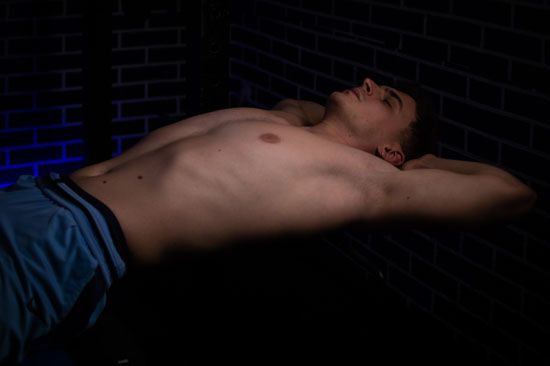
To do the final breathing exercise on the bioenergetic stool, you must sit on the towel and fully rest your upper body on the couch or bed. Because you have the pectus excavatum deformity, most muscular tightness and tension are around your chest and frontal shoulders.
This third exercise focuses more on the tight hips. You won't feel the stretch on the breastbone as in the previous two variations. However, it will help you correct your poor posture, especially if you're sitting at a desk most of the day. Perform about ten breaths.
After you do these breathing exercises, your mood will immediately improve. You feel very energized. I recommend doing this before your pectus excavatum bodybuilding workout because it will stretch the tight muscles that restrict natural body movement when doing the bench press, overhead press, barbell row, pull-ups, etc.
In addition, it will improve your pectus posture and increase your flexibility for squatting, pulling, and pressing.
STOMACH VACUUM
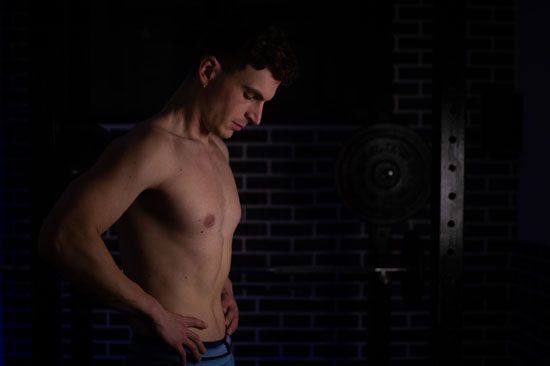
The stomach vacuum exercise strengthens your transverse abdominis muscle, a deep line ab muscle. Before doing this exercise, I recommend deep breathing for 30 seconds. Your focus should be moving your belly with your breath, not your chest. The warm-up will help you loosen up the stomach muscles.
To do this exercise, you must breathe out entirely and pull your stomach in without taking a breath. Try to suck your gut inside. Visualize that your abs are touching the back of your spine. After doing this powerful exercise for a few weeks, you'll notice a greater core muscle activation when doing other exercises.
That will help you eliminate rib flaring; makings pectus excavatum less noticeable. Try to do five sets of 10-second holds in a day. Rest for about 30 seconds between each set. Do this three times a week. Don't do this exercise after you're finished eating.
The exercise will feel very uncomfortable, and you won't be able to activate the transverse abdominal muscles correctly. Wait for at least 2 hours. I do this exercise after I wake up in the morning and before I have my breakfast.
WIM HOF BREATHING
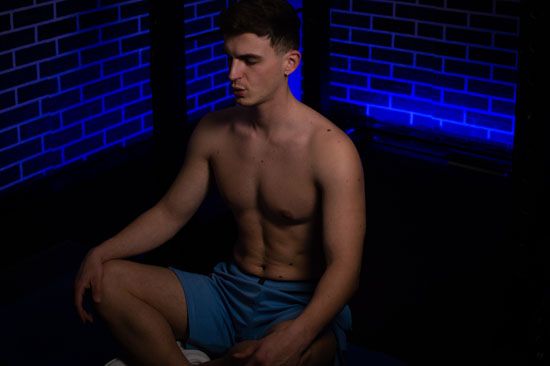
The first step is to get comfortable. For this breathing exercise, you can either sit or lay. I prefer to sit down in a meditation sitting position. You should be able to feel the expansion of your lungs without any constriction. Stay relaxed, close your eyes and get rid of any thoughts. Start inhaling through your nose, and exhale through your mouth.
You need to inhale and feel your stomach expanding fully. Perform 40 breaths quickly and forcefully. It is normal to get light-headed and experience tingling feelings in your fingers and feet. I did this workout with my friend, a basketball player who doesn't have pectus excavatum. I felt more light-headed than him.
However, I didn't experience any harm from that. Even Wim Hof addresses that these side effects are harmless. The last breath of the round of 40 should be fuller than the last breaths.
Then, let the air out and stop breathing altogether. Hold this until you need to inhale again. When you need to breathe in again, take a deep breath and fill your lungs.
You should feel your lungs and stomach expand. Then, hold your breath for another 15 seconds and exhale. This completes one cycle. Repeat the whole sequence four times without stopping. After this, you'll notice how your sternum is slightly elevated. You'll feel a sensation you haven't sensed for a long time.
DOES THE WIM HOF METHOD HELP?

Recently, there has been a lot of buzz about breathing exercises. That puts a smile on my face. Back in 2016, I heard about Wim Hof. He climbed Mount Everest wearing nothing but shoes and shorts.
He also sank under-ice water for about two hours without decreasing his body temperature. I also heard he is doing a lot of breathing exercises and cold water therapy.
When I was diagnosed with pectus excavatum, my doctor suggested I inflate balloons to improve my lung capacity. I started doing that and felt an immediate rise in my sunken sternum. However, that seemed too simple for me, and I ignored breathing work until I discovered that Wim Hof has a program about utilizing breathing to improve your health.
I started doing the Wim Hof method and saw a tremendous impact from his breathing techniques, which consisted of forceful inhalations and exhalations, followed by a breath-hold.
I sensed a feeling that I had never experienced in my life before. The breathing energized my body, my chest was flawlessly expanding, and I could feel no barriers in my breathing even while I was doing my intense bodybuilding exercises.
Since then, I have been a massive fan of his. I highly recommend his breathing exercises to every pectus excavatum sufferer. A lot of people are ignoring the power of the breath.
WHAT IS THE WIM HOF METHOD?
The Wim Hof Method utilizes three robust systems. Click the following link to read about the science behind this method.
COLD SHOWERS
Cold therapy will be beneficial to you both physically and mentally. After practicing cold showers, your breathing will improve, and you'll breathe more deeply.
When you turn the water cold, your body will be forced to breathe heavily. That will help you raise your energy levels. Many people who practice cold showers are amazed by the benefits they reap.
I started implementing cold showers daily while practicing the Wim Hof Method in 2016. Since then, I have recommended them to everyone, especially people suffering from the pectus excavatum deformity. They are proven to:
- Increase the production of endorphins
- Improve your mood
- Increase weight loss
- Reduce inflammation
- Strengthen your immune system
- Balance your hormones
- Improve your sleep
BREATHING WORK
The second most important principle of the Wim Hof method is breathing work. You can feel your sunken sternum elevated after a few weeks of forceful breathing. You'll feel it after you do the breathing sessions.
Practicing breathing exercises has a lot of potential for a person suffering from an inverted chest condition. It will feel more energized, reduce stress, and improve your immune system.
COMMITMENT
You'll have to commit to practicing cold water therapy and breathing exercises daily. This will make you more disciplined and will teach you about patience. This last pillar of the Wim Hof method is hugely beneficial if you're willing to fix the deformity non-surgically.
That also requires a lot of self-discipline and commitment. All of that will be easier while you're doing the Wim Hof Method. In my opinion, it is more challenging to stay in a cold shower for 60 seconds than to do what it takes to follow the non-surgical method.
CONCLUSION
Breathing exercises alone can't fix pectus excavatum. However, they are proven to help you improve your poor pectus posture, improve your already reduced lung capacity, increase energy, boost self-esteem, and stretch the tight chest musculature.
You can even feel an elevation in your funnel breastbone after finishing them. When my deformity was at its worst phase at age 16, I lacked energy and had trouble socializing with others. The mental and physical pain motivated me to seek a non-surgical pectus excavatum solution. I was introduced to Elliott Hulse, who improved my life.
The breathing and stretching exercises helped me to correct the deformity and increase my lung capacity. In this article, I shared the breathing exercises I found most beneficial for my deformity. I highly recommend you try all of the exercises I talked about. Pay special attention to those that make you feel very uncomfortable.
That's because you have muscular imbalances that restrict your natural breathing patterns. I, including some of my clients, experienced discomfort while doing the breathing exercises on the bioenergetic stool.
Words can't express my gratitude to Elliott Hulse, who introduced me to those exercises. The breathing exercises take no more than 15 minutes a day. All you have to do is cut your presence on social media for 15 minutes. That short amount of time has the potential to change your life for the better.
I hope you will reap the fantastic benefits of the exercises I showed you. Those changed my life for the better, and I sincerely hope they will do the same to you.
15 Sources
- Kelly RE, Obermeyer RJ, Nuss D. Diminished pulmonary function in pectus excavatum: from denying the problem to finding the mechanism. Ann Cardiothorac
Surg. 2016 Sep;5(5):466–75. - Hadolt B, Wallisch A, Egger JW, Höllwarth ME. Body-image, self-concept and
mental exposure in patients with pectus excavatum. Pediatr Surg Int. 2011
Jun;27(6):665–70. - Zhao L, Feinberg MS, Gaides M, Ben-Dov I. Why is exercise capacity reduced in
subjects with pectus excavatum? J Pediatr. 2000 Feb;136(2):163–7. - Kokatnur L, Vashisht R, Rudrappa M. Diaphragm Disorders. In: StatPearls [Internet]. Treasure Island (FL): StatPearls Publishing; 2022 [cited 2022 Dec 4]. Available from: http://www.ncbi.nlm.nih.gov/books/NBK470172/
- Muscles of respiration. In: Wikipedia [Internet]. 2022 [cited 2022 Dec 4]. Available from: https://en.wikipedia.org/w/index.php?title=Muscles_of_respiration&oldid=1121163006
- Boyle KL, Olinick J, Lewis C. THE VALUE OF BLOWING UP A BALLOON. N Am J
Sports Phys Ther. 2010 Sep;5(3):179–88. - Jun HJ, Kim KJ, Nam KW, Kim CH. Effects of breathing exercises on lung capacity
and muscle activities of elderly smokers. J Phys Ther Sci. 2016 Jun;28(6):1681–5. - Transverse abdominal muscle. In: Wikipedia [Internet]. 2022 [cited 2022 Dec 4].
Available from: https://en.wikipedia.org/w/index.php?title=Transverse_abdominal_muscle&oldid=1104217208 - Welcome to the Official Wim Hof Method Website [Internet]. [cited 2022 Dec 4].
Available from: https://www.wimhofmethod.com/ - Man who climbed Everest in shorts can teach you how to control your immune system [Internet]. [cited 2022 Dec 4]. Available from:
https://www.thejournal.ie/wim-hof-everst-2222484-Jul2015/
677 - Discover the science behind the Wim Hof Method [Internet]. [cited 2022 Dec
4]. Available from: https://www.wimhofmethod.com/science - Physical and Mental Benefits of Cold Therapy [Internet]. Matcha.com. [cited
2022 Dec 4]. Available from: https://matcha.com/blogs/news/resilience-part-iphysical-and-mental-benefits-of-cold-therapy-2019 - Zaccaro A, Piarulli A, Laurino M, Garbella E, Menicucci D, Neri B, et al. How
Breath-Control Can Change Your Life: A Systematic Review on Psycho-Physiological Correlates of Slow Breathing. Front Hum Neurosci. 2018 Sep 7;12:353. - Ma X, Yue ZQ, Gong ZQ, Zhang H, Duan NY, Shi YT, et al. The Effect of Diaphragmatic Breathing on Attention, Negative Affect and Stress in Healthy
Adults. Front Psychol. 2017 Jun 6;8:874. - Asimakos A, Toumpanakis D, Karatza MH, Vasileiou S, Katsaounou P, Mastora
Z, et al. Immune cell response to strenuous resistive breathing: comparison
with whole body exercise and the effects of antioxidants. Int J Chron Obstruct
Pulmon Dis. 2018 Feb 7;13:529–45.




